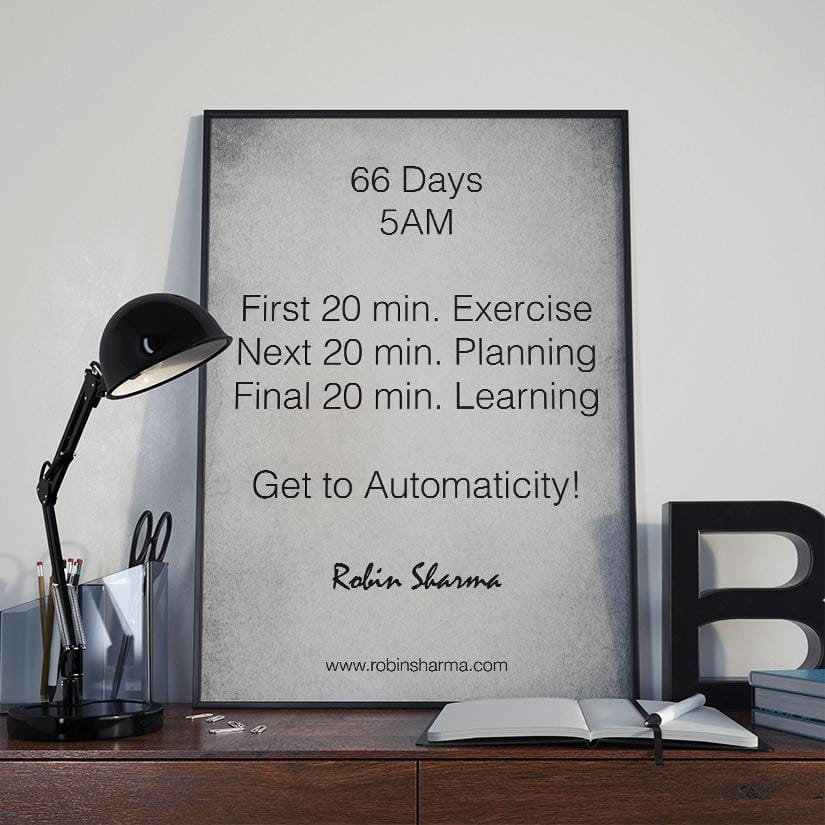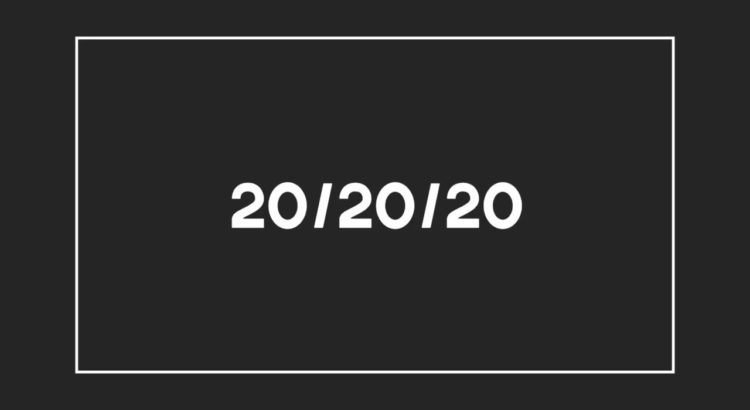In the words of Robin Sharma: The way you start your day powerfully shapes how productively you live it. This is the purpose of the 20/20/20 formula, to improve your productivity by applying this new morning routine, starting the day with exercise, contemplation, and learning.
This formula is included on his successful best-selling book The 5AM Club.
This secret formula is the result of studying the mindset and habits of the great minds, leaders, artists, scientists, and in general great performers.
20/20/20, what is this about?
Basically, Robin Sharma, in his book, wants to share with us that the “great geniuses and business titans” wake up earlier to mastery their productivity by owning their morning.
And after waking up, they usually spend time doing exercise, contemplation, and self-organization, and learning. That is what the 20/20/20 formula is about: dividing the hour after waking up in 20-minute sections to do it.

Let’s deepen a little into every step of the formula…
First 20 minutes: Intense exercise
It is important to emphasize the word intense. It is suggested to do some HIIT exercises. Jim Kwik, superbrain celebrity trainer, recommended HIIT or calisthenics, and especially the “evil” burpees on his morning routine. Anyway, most of the people I’ve seen usually do running in the morning.
Disclaimer: Doing a workout in the morning doesn’t have to substitute any other routine or habit that you have related to this topic. If you usually go to the gym, to Crossfit box, or enjoy running, at midday, afternoon, evenings, you should keep it. Doing some exercise in the morning is recommended for empowering yourself, your day start, and is also good for your body and brain. But could be complementary.
There is some science behind that first point. Sweating releases BDNF, a brain chemical that grows neural connections. Also, doing workout also releases dopamine, the neurotransmitter of motivation, and serotonin, which makes you feel happy.
Also doing exercise moves blood and oxygen to the brain. It is said that “moving your body, grows your brain”. And as important as doing some exercise is to drink water. Hydration is key in the morning, for your body and brain. Brain is composed mostly of water (73% according to the Journal of Biological Chemistry, but you’ll find lots of documents saying 80% or even 85%).
Second 20 minutes: Contemplation
Before day starts, it is time to focus on what is important to yourself, to review your priorities and goals. Because “clarity precedes mastery”. Before daily responsibilities, this is the time that you can dedicate yourself to think about the person you are and the one you want to be. Reflection is an important transformation source. Knowing you better will help you to act and make decisions more accurately.
It is usually recommended for the practice of mindfulness. Studies show that meditation helps reduce cortisol, reducing stress. Stress management is key for emotional equilibrium and also for physical health.
I am not an expert about Mindfulness, just a newbie. But If you stay curious about its benefits, I recommend you to investigate further about Jon Kabat-Zinn and his Mindfulness-based stress reduction (MBSR). Also, if you would like to know about mindfulness in business, you could search for Google’s Search Inside Yourself program.
Also, another common practice is to write a journal. Studies have found that many geniuses journal (Da Vinci, Einstein, Edison,…), and you will find easily lots of celebrities that also do it. But do they journal because they’re geniuses, or does the process of journaling and reflection make them geniuses?
Journal helps to concentrate, to clarify ideas, to raise creativity to mastery, to express gratitude, to release emotions, and avoid keeping them, to save and revive experiences, etc.
I don’t like handwriting, but studies say handwriting is better than typing to retain information. Handwriting forces you to synthesize the information, so you remember it better and are more likely to recall it later. Also, if you are fully digital, it is possible to handwrite over a pad or tablet.
Las 20 minutes: Learning
Last of the 20/20/20 formula sections, and this is the moment for growth. There is one thing that all great performers have in common, and it is the love for learning. Did you know that leaders are readers, and that great CEOs use to read four to six books per month?
There is no rule, you could learn in many ways. Books, audiobooks, documentaries, courses, or any kind of publishings. Use this 20-minute daily pill to grow yourself personally and professionally, to stay up to date, to learn from the best. This is the way to be the better version of yourself that you deserve. And while you become better, you also help people around you to become better.
It is demonstrated that our brain only can keep focus for 45 minutes, then lose steam and needs to rest. Limit learning time to 20 minutes helps to have a more focused experience and also to avoid procrastination. This is based on the Pomodoro technique.
You’ll fill find this practice very often used on e-learning, in the most recent MBA programs, MOOCs, etc.
How to apply this formula?
Now that we know what is the 20/20/20 formula about, and the recommendations for every section of this “victory hour”, I will share my particular case.
Starting for the 5 am rule, I am waking up at 6 am. It is not necessary in my case to wake up earlier. We have different schedules in Spain, probably waking up at 6 is like doing it at 5. This is my excuse. My personal issue is that I am waking up earlier but not sleeping the recommended eight hours. That’s a real problem that I need to solve.
The first “complain”. If you follow the formula verbatim, you’ll find that it is almost impossible to do the 20 minutes of the 3 blocks sequentially. So you won’t be able to workout, meditate, and learn, 20 minutes each, in one hour.
For instance, when you workout, it is normal to rest a little after HIIT, even if the next block is for meditation. And I am pretty sure that you need some minutes to wake up and prepare for exercise.
I usually workout based on my daily plan provided by Freeletics coach, so time depends on the day. And I can assure you that I spend more time than 20 minutes between warm-up, exercises, stretching, and resting times.
Also, learning for 20 minutes depends on what you want to study. Maybe you’re doing a course of 15 minutes pills, or you need 30 minutes someday, or maybe you plan to read and it will more less suit time. Same for writing a journal, reviewing your daily plan, practicing mindfulness, or any breathing techniques.
I am starting (again) with mindfulness practice, so I am doing only 10 minutes, that I will probably increase to 15 in the next days. I don’t write a journal, only this blog, and my writing process is quite slow and painful nowadays.
About learning, I am always involved in new courses (e-learning), which usually are made of short videos, and I plan to read tons of books this year, so the third “20 minutes” are mostly dedicated to this. When I have limited time, maybe because I exceeded the workout time, I usually read.
Anyway, don’t be too strict with the formula. Understand the formula as a guide, a template that could be modified if necessary. The real key is to follow the recommendations, to create the habit, to be constant and consistent. If you do some exercise, dedicate some time to reflection and meditation, and also to add some new learnings every morning, benefits will surely come.
I hope you found this interesting. It is a real challenge to change morning habits this way.
Do you have any experience doing it? Please, share them! I would love to learn from others!
I hope you liked it. If so, please share it! Do not hesitate to add your comments. And, if you want to stay up to date, don’t miss my free newsletter.
Thanks for reading.
Also published on Medium.
Join the FREE Newsletter
Also published on Medium.
